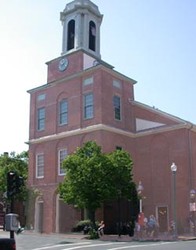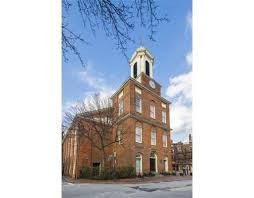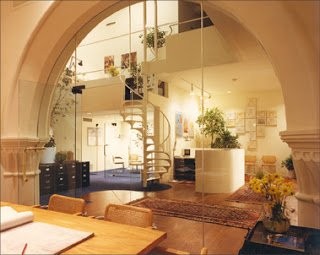Charles Street Meeting House (Black Heritage Trail Site 5)
Introduction
Text-to-speech Audio
The Charles Street Meeting House is the fifth stop on the Black Heritage Trail in Boston. Built in 1807 by the Third Baptist Church, the Charles Street Meeting House, then called the Charles Street Baptist Church, is significant as the location of many anti-slavery meetings in the decades prior to the Civil War. During its first decades, the church practiced racial segregation with Black attendees being relegated to the gallery and generally barred from many of the privileges of full membership in the congregation. In 1836, abolitionist Timothy Gilbert was expelled from the church for inviting African Americans to sit beside him in his regular pew. In subsequent decades, the congregation took a stand against slavery and African Americans like Frederick Douglass and Sojourner Truth delivered speeches alongside white abolitionists like Charles Sumner. White membership in the congregation dwindled and the congregation sold the building to the Charles Street African Methodist Episcopal Church in 1876. That congregation had been formed in 1833 and had grown to become the largest Black congregation in Boston after the Civil War. The congregation sold the building in 1939 owing to the declining number of African American families in the Beacon Hill neighborhood.
Images
This building was home to a variety of congregations until 1979 and home to the Charles Street AME from 1876 to 1939.

Numerous abolitionists spoke at this building in the decades leading up to the Civil War.

Despite the historic appearance of the exterior, the interior has been significantly altered and is home to several Boston firms.

Backstory and Context
Text-to-speech Audio
The Charles Street Meeting House was built in 1807 by the Third Baptist Church, a predominantly white congregation that practiced segregation. This seating rule would be challenged by Timothy Gilbert, a white abolitionist, in the 1830s. He and other white abolitionists later established Tremont Temple, one of the first integrated congregations in America. In the 1840s and 1850s, Charles Street Meeting House became home to many anti-slavery movements and speakers. Among those speakers were Harriet Tubman, Frederick Douglass, and Sojourner Truth.
The original congregation saw a decline in white membership and sold the building to the leading African Methodist Episcopal congregation in 1876. The First African Methodist Episcopal Church, AME for short, was the first Black independent denomination in the United States. The AME saw declining membership as fewer Black families lived in the neighborhood, and the congregation sold the building in 1939. The new owners, the Charles Meeting House Society, rented the building to the Albanian Orthodox, the Society for the Preservation of New England Antiquities, the Massachusetts Universalist Convention, the Unitarian Universalists, and other organizations over next few decades. A private owner purchased the building in 1979 and sold it to a group of historic preservationists the following year.
The Charles Street Meeting House Associates raised funds to repair and restore the building. After renovations he Charles Street Meeting House has become office space with a very modern interior but an exterior that won the American Institute of Architects Excellence in Architecture Award in 1983 for its historical integrity. While the interior is quite modern, the exterior looks much as it did when the building was home to the AME church and the property is part of Boston's Black Heritage Trail and significant as a site of abolitionist meetings and as one of the last Black institutions to leave Beacon Hill.
The original congregation saw a decline in white membership and sold the building to the leading African Methodist Episcopal congregation in 1876. The First African Methodist Episcopal Church, AME for short, was the first Black independent denomination in the United States. The AME saw declining membership as fewer Black families lived in the neighborhood, and the congregation sold the building in 1939. The new owners, the Charles Meeting House Society, rented the building to the Albanian Orthodox, the Society for the Preservation of New England Antiquities, the Massachusetts Universalist Convention, the Unitarian Universalists, and other organizations over next few decades. A private owner purchased the building in 1979 and sold it to a group of historic preservationists the following year.
The Charles Street Meeting House Associates raised funds to repair and restore the building. After renovations he Charles Street Meeting House has become office space with a very modern interior but an exterior that won the American Institute of Architects Excellence in Architecture Award in 1983 for its historical integrity. While the interior is quite modern, the exterior looks much as it did when the building was home to the AME church and the property is part of Boston's Black Heritage Trail and significant as a site of abolitionist meetings and as one of the last Black institutions to leave Beacon Hill.
Sources
Boston, Massachusetts History and Architecture -- Welcome to ... (n.d.). Retrieved October 5, 2014, from http://www.iboston.org/mcp.php?pid=charlesStreetMtgHouse
Museum of African American History, Boston - Black Heritage Trail Site 5. (n.d.). Retrieved October 5, 2014, from http://www.afroammuseum.org/site5.htm
United States. National Park Service. (2014, September 10). Charles Street Meeting House. Retrieved October 5, 2014, from http://www.nps.gov/boaf/historyculture/charles-street-meeting-house.htm
